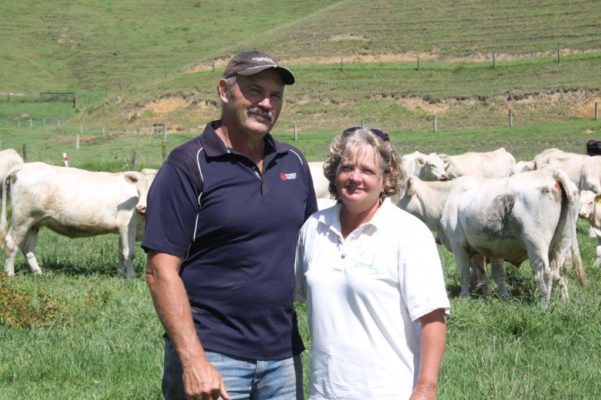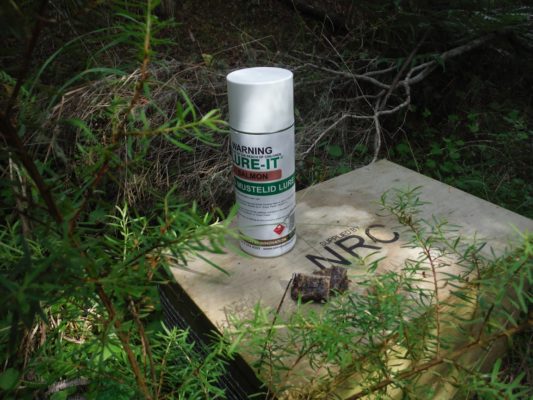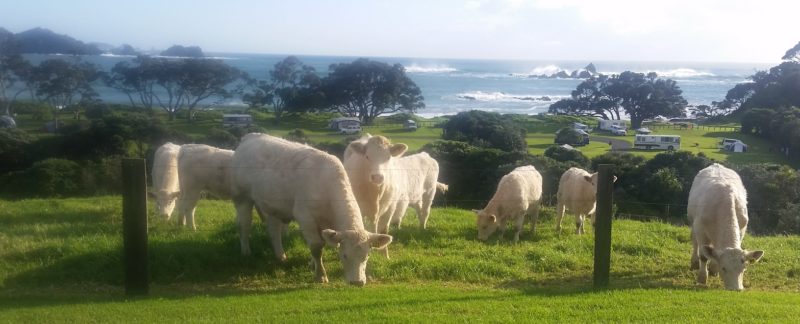The first time that someone from Northland’s ‘Kiwi Coast’ project visited Greta and Craig Harman’s Charolais cattle farm to monitor for kiwi presence, they didn’t need to scramble through bush looking for kiwi sign or stay up late playing kiwi call recordings to confirm that kiwi were present.
“There were fresh kiwi footprints in the clay farm track,” recalls Greta. “We’ve always had kiwi on the property,” she adds. “There’s quite a bit of bush on the boundary and we’ve got a big chunk of bush fenced. And the kiwi are breeding!”

Craig and Greta have a close working relationship with ‘Kiwi Coast’, Department of Conservation and Northland Regional Council. They’re keen conservationists and their Whananaki farm includes areas of fenced wetlands in the gullies where fernbirds can be found. Pateke are doing well too.

“Ngaire Tyson from Kiwi Coast did a presentation at our farm open day last week,” says Greta. “It was a beautiful day. Over 90 people turned up. Ours is a very steep farm so for health and safety reasons we couldn’t let people drive themselves around in 4WDs, so we took them to a couple of spots in the farm to show where we’ve fenced the bush, waterways and wetlands.”
As well as fencing off high biodiversity value areas like the gully wetlands and replanting areas in natives, Greta heads the Whananaki Landcare Group.
“When I contacted Kiwi Coast a couple of years ago to see about forming a Landcare Group, Ngaire told me that the first person who rings usually ends up running it,” says Greta. “And that’s how it worked out. We did it to join up with existing Landcare Groups to the north and south. We’re all local landowners and we use the group to get funding.”
That funding is used to pay for traps and a professional trapper.
“There are pateke here as well as kiwi,” Greta says. “DOC has funded the low-lying coastal trapping to protect pateke for a number of years and we have the best-improved population on the mainland.”
“The landcare group trap further back into the hills to protect the kiwi,” she explains. “With so many landowners it’s more successful to use a professional trapper, but a number of people do their own private trapping on lifestyle blocks and next to their house as well. All our trapping results go into TrapNZ.”
DOC 200 traps are used to target stoats and weasels – the main threats to pateke and kiwi – they catch a lot of rats too.
“We also get the odd feral cat and use a combination of Steve Allen traps, live capture, MK6 and Good nature traps as well as the DOC 200s,” says Greta. “The use of a good combination of traps covers a wide range of pests.”
“Every time the trapper goes into a new block he catches a lot initially with catches dropping off quickly . A lot of traps sit all year with one or two catches which is why it’s good to use a professional. Local fur trappers go through and get the possums first, followed by baiting.”
The large number of holiday baches in the area – unoccupied for much of the year outside the summer months – is another reason why it makes sense to use a professional trapper.
“There are 4 camping grounds in the area too,” Greta says. “In summer the local population swells from about 300 to maybe 3000 people.”
Kiwi and pakete aren’t the only rare natives living on the farm. Fernbirds are doing well in the wetland areas, particularly since the gullies were fenced off.

“Northland Regional Council do 5-yearly monitoring of the wetlands,” says Greta. “The first year, before the wetlands were fenced, there were a few fernbirds at one site. Five years later when they came back the wetlands had dramatically improved in all aspects of plant diversity/health, water quality, and swamp density with fernbirds calling at all 4 sites within 3 wetlands.”
The warm, wet Northland climate helps with the natural regeneration process, but replanting of natives is also carried out.
“Once the cows are off, regeneration happens quite easily on its own in the Northland region,” Greta says, “But we’ve also planted tea-tree – manuka and kanuka. We plant a combination that is suited for bees year-round and have 3 sites on the farm for beekeepers.”
The Harmans have a close relationship with their local school and community and the school children have also been helping out with native planting.
“The local school is part of Enviroschools and they grow native plants. Each year they come and plant them out in the wetlands,” says Greta. “The school came to our open day too, as a class group. For 10 years we used to host a trail ride to raise funds for the school and community,” she adds.
Greta and Craig Harman were not only the Northland winners of the Predator Free Farm Award and the Regional Council Water Quality Enhancement Award – they were also the overall Northland Ballance Farm Environment Award Supreme regional winners.
“We’ve done a lot,” Greta agrees, “But it’s not out of the ordinary. It should be the baseline for what everyone does. We all have to do our bit now to make sure we do not lose anymore of our native species before we get predator free.”

